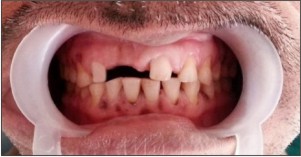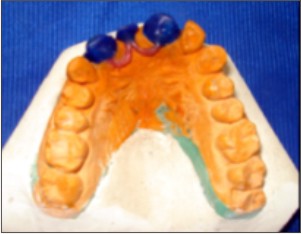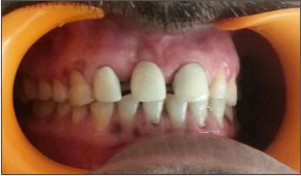Introduction
Different esthetic treatment options are available for replacement of single anterior tooth i.e. implant supported restorations as well as conventional porcelain fused to metal and resin-bonded fixed partial dentures.[1] Most of the times, drifting of teeth into the edentulous area occurs which causes reduction of the available pontic space, but sometimes a diastema which exists before an extraction may result in excessive mesiodistal dimension to the pontic space.[2] This is a challenging clinical situation for the prosthodontist and leaves him in a dilemma whether to close the space or maintain it in the restoration to simulate natural tooth appearance. If diastema is to be maintained and implant- supported prosthesis is not selected as a treatment option, loop connector fixed partial denture may be the simplest and best solution which also provides optimum restoration of esthetics.[3] Connectors are basically components of the fixed partial denture that joins the retainers and the pontics together.[4] Loop connectors are non rigid type of connectors required to maintain the existing diastema in a planned fixed prosthesis.[5] Loop connectors consist of a loop on the lingual aspect of the prosthesis that connects adjacent retainer and/or pontics. The loop connectors may be cast from sprue wax that is circular in cross-section or shaped from platinum-gold-palladium (Pt-Au-Pd) alloy wire.[6] This article presents a case with excessive space in the anterior region treated with a loop connector to achieve ideal esthetic results in the maxillary anterior segment.
Case Report
A 37-year-old male patient reported to the department of prosthodontics, with the chief complaint of missing teeth in upper right front region. On intraoral examination, it was seen that right maxillary central incisor was missing and the edentulous space was large (Fig.1). A conventional FPD was not possible due to large spaces between the anterior teeth. Patient was neither willing for implant placement nor a removable partial denture. He wanted a fixed alternative for his missing tooth. Spring cantilever FPD was not planned as no posterior tooth needed a crown.[7] So treatment plan chosen was a loop connector FPD with the right central incisor as pontic and left central incisor and right lateral incisor as the abutment teeth, maintaining diastema between the pontic and the retainers.
 | Fig. 1 - Pre-treatment view
 |
Procedure
Tooth preparation was done in relation to the left central incisor and right lateral incisor, with slight subgingival finish line. Retraction procedures were carried out, a polyvinyl siloxane (Aquasil soft putty and Aquasil LV) impression was made using putty reline technique in a rim-lock impression tray and removable dies were fabricated. Die ditching was done to expose the restoration margins.
Wax pattern for the retainers were fabricated with blue inlay wax. The palatal loops connecting the pontic to the retainers on the left central incisor and the right lateral incisor were made with round 14 gauge wax (Fig.2). Care was taken to keep the loops away from rugae. Rest of the laboratory procedures were common with the conventional metal-ceramic FPD construction. The loop connectors in the final prosthesis were polished to high shine (Fig. 3 & 4).
 | Fig. 2 - Wax pattern with palatal loops
 |
 | Fig. 3 - Post treatment view
 |
 | Fig. 4 - Occlusal view of final prosthesis
 |
Discussion
The presence of the anterior extensive diastema is a difficult esthetic problem to resolve with conventional fixed partial dentures.Maximum esthetic results may be obtained only if the natural anatomic forms of the teeth are protected and the diastema is maintained.[8] Although implants and removable partial denture are also the options but loop connector fixed partial denture is used in cases of excessive mesiodistal width of pontic space when fixed partial dentures are planned. In rare cases when the posterior teeth are healthy and sound, they are used as abutments to replace a maxillary anterior tooth with diastema, using resin bonded spring cantilever fixed partial denture.[9] The palatal connector in spring cantilever fixed partial denture acts as a loop connector. However, the connector here is long, thin and resilient bar, closely adapted to the palate so that it is partly supported by soft tissue.[10] It may deform, if thin, and produces coronal displacement of the pontic. It may also interfere with speech and is often poorly tolerated.
The size, shape and position of connector affects the success rate of the prosthesis.[11] In a loop connector fixed partial denture, the connector consists of a loop on the lingual aspect of the prosthesis that connects adjacent retainer and/or pontic. The loop may be cast from sprue wax that is circular in cross-section or shaped from platinum-gold-palladium (Pt-Au-Pd) alloy wire. Designing of loop connector should be such that it does not interfere with plaque control. Thickness of the connector should be adequate to prevent deformation but not so much that it becomes conspicuous to the tongue. Connector should have an intimate contact with overlying mucosa else the space created causes irritation to patient’s tongue.
In the above case, the loop connector FPD not only addressed the problem of excessive mesio-distal width pontic space, but it also corrected the axial alignment of the left central incisor and the plane with respect to the right lateral incisor.
Conclusion
Although they are rarely used, loop connectors are sometimes required when an existing diastema is to be maintained in a planned fixed prosthesis, as in the above case. A loop connector FPD offers a simple solution to a prosthodontic dilemma involving an anterior edentulous space.
References
1. Marinello CP, MeyenbergKh, Zitman N. Single tooth replacement: some clinical aspects. J Esthet Dent 1997; 9:169-78.
2. Tylman’s Theory and Practice of Fixed Prosthodontics.8th ed. St Louis: Ishiyaku Euroamerica Inc; 1989.p. 12-3
3. Kamalakanth S, Arbaz S. Anterior loop connector fixed partial denture: A simple solution to a complex prosthodontic dilemma. Journal of Indian Prosthodontic Society 2008;8:162-4
4. Rosenstiel S, Land M, Fujimoto J. Connectors for partial fixed dental prosthesis. Contemporary fixed prosthodontics. 4th edition. New Delhi, Elsevier,2007;843-69
5. Shillingburg HT Jr, Hobo S, Whitsett LD, Jacobi R, Brackett SE. Fundamentals of fixed prosthodontics, 3rd edition. New Delhi, Passi, 2002; 509-12.
6. Stefen F, Rosensteil, Land MF, Fujimoto J. Contemporary fixed prosthodontics. 3rd ed. St Louis; Mosby; 1995.p.564-5
7. Smith BG. Planning and making crowns and bridges, 3rd edition. London, Martin Dunitz Ltd, 1998; 191- 206.
8. Bello A, Jarvis RH. A review of esthetic alternatives for the restoration of anterior teeth. J Prosthet Dent 1997; 78:437-40.
9. Taggart J. Resin bonded spring cantilever bridge. Restorative dentistry1990; 6:4-5.
10. Bartlett DW, Fisher NF. Clinical problem solving in prosthodontics, London, Churchill Livingstone, 2003; 45.
11. Dange SP, Khalikar AN, K. Shiv. Non- Rigid connectors in fixed dental prosthesis - A Case Report. JIDA 2008; 2: 356-8.
|